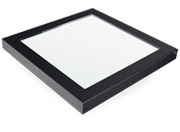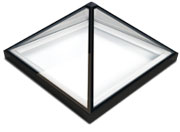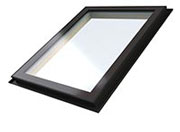Planning a Kitchen Extension with Skylights
Thinking of adding a skylight kitchen extension to your home? It’s a fantastic idea! Installing a rooflight extension allows you to expand your kitchen and bask in the natural light while preparing meals, hosting guests, or enjoying family dinners. Skylights and roof windows provide numerous benefits beyond their aesthetic appeal, such as increasing natural light, reducing reliance on artificial lighting, and enhancing well-being.
Moreover, rooflights can channel natural light deeper into your home, crucial when adding an extension. Plan, design, and build a stylish kitchen extension with skylights using these ideas, exploring various ways to integrate roof glazing into your new space with inspiration from real-life projects. From improving energy efficiency to creating a beautiful, bright space, skylight kitchen extensions offer a range of advantages for modern living..
Brighten Your Kitchen Extension
Incorporating a roof window into your kitchen extension design instantly adds architectural depth, enhancing even the simplest layouts.
Introducing light from above beautifully illuminates kitchen areas, such as islands and countertops, with natural light, creating a welcoming and functional space. The presence of a rooflight also makes small kitchen extensions feel taller, wider, and more engaging.
For instance, in a side return extension, adding a wide skylight above the cooking zone achieves this effect, while retaining the old exterior window ensures darker internal spaces benefit from additional natural light. You can also see how to maximise light through windows doors here.
Advantages of Skylight Kitchen Extensions
Skylight kitchen extensions offer numerous benefits for your kitchen:
- Energy Efficiency and Cost Savings: Skylights and roof lanterns reduce reliance on artificial lighting, increasing energy efficiency and helping you save on utility bills.
- Ease of Installation: You typically don’t need full planning permission to install rooflights if you adhere to the regulations covered by permitted development rights.
- Space Enhancement: Skylights are a cost-effective way to make your room feel larger and more open.
- Ventilation Options: By choosing opening rooflights, you can also improve ventilation, ensuring fresh air circulates throughout your kitchen.
To explore and understand more benefits, you can visit our blog: The Health Benefits of Natural Daylight.
Can I Install Skylights in My Kitchen Extension?
Yes, you can install skylights in your kitchen extension, provided it is a single-storey structure or a two-storey extension with a double-height void above the kitchen or living space. Skylights can be incorporated into pitched, lean-to, and flat roof extensions. However, consider privacy and ensure you won’t be overlooked by neighbors.
When selecting a roof window, it’s essential to understand the terminology. Terms like skylight, rooflight, and roof window are often used interchangeably, which can be confusing. Generally, skylights are used on roofs with a pitch of 15-75 degrees and sit more flush with the roofline. Rooflights, on the other hand, are designed for flat roofs or those with a pitch between 0-15 degrees and require an upstand. Knowing these distinctions will help you choose the appropriate type of rooflight for your extension.
Do I need a skylight or a rooflight and how to know?
When selecting a roof window, it’s essential to understand the terminology. Terms like skylight (a.k.a. pitched window, pitched glass), rooflight (a.k.a flat roof window, flat glass, flat skylights) often used interchangeably, which can be confusing. Generally, skylights are used on roofs with a pitch of 15-75 degrees and sit more flush with the roofline and use tiles or possibly metal to weather. Rooflights, on the other hand, are designed for flat roofs or those with a pitch between 0-15 degrees and require an upstand and can be weathered lots of ways like EPDM, TPO, flet, fiberglass, etc. Knowing these distinctions will help you choose the appropriate type of rooflight for your extension.
Skylight options for pitched roofs
So, you have a pitched roof and you want to add more light. What are your options? There are many considerations, but it mainly comes down to what your main priority is. Here are your options based on different needs and budgets:

Budget-Friendly Options: Velux or Fakro Skylights
If you are on a budget, you may want to look at products from brands like Velux or Fakro. These skylights are mass-produced in standard sizes, making them cost-effective. Here are some key points about these options:
- Sizes Available: Typically range from around 600mm x 600mm to 1300mm x 1300mm.
- Types: You can choose between fixed units and opening units.
- Cost: More affordable due to standardized production.
- Design Impact: These skylights are fairly common and don’t offer much in terms of a ‘wow’ factor.
Premium Options: Bespoke Pitched Skylights
If you want something more impressive, consider a bespoke pitched skylight. These skylights are custom-made to fit your specific requirements, offering a more dramatic impact on your space. Here are the benefits of choosing bespoke skylights:
- Custom Sizes: Can be made in any size, going up to huge 6-meter units or split into multi-panel systems.
- Types: Available as fixed or opening units.
- Glazing Options: Can be double or triple glazed for enhanced insulation and energy efficiency.
- Design Impact: Very popular for side extensions, maximizing the light from a pitched lean-to roof, and transforming your room with a stunning feature.
Choosing the Right Skylight for Your Needs
When deciding on the best skylight option for your pitched roof, consider the following factors:
- Budget: Determine how much you are willing to spend. Standard sizes from Velux or Fakro are more affordable, while bespoke options will cost more but offer greater customization.
- Aesthetic Impact: Decide how important the visual appeal is for your project. Standard skylights are functional but less striking, whereas bespoke skylights can create a major visual impact.
- Functionality: Think about whether you need the skylights to open for ventilation or if fixed units will suffice. Opening units can improve airflow and reduce the need for additional ventilation solutions.
- Energy Efficiency: Consider the type of glazing. Double or triple glazing options can improve insulation and energy efficiency, which is particularly important for larger skylights.
What are the flat roof rooflight options?
When considering flat rooflights, you have a variety of options that cater to different budgets and requirements. The main considerations are similar to those for pitched rooflights: your budget and specific needs.
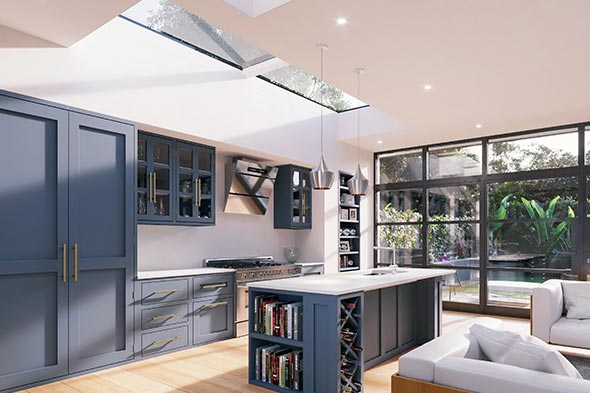
Fixed Rooflights
- Low-End Budget: Polycarbonate domes are very competitively priced and widely available. However, they can be noisy when it rains and are less thermally efficient.
- Mid-Range: Stepped glass rooflights, often referred to as “fake rooflights,” do not have a frame and sit on top of your upstand. These offer a sleeker appearance but may lack the durability and thermal efficiency of higher-end options.
- High-End: System rooflights, like those offered by our company, come with frames and various advanced features. They are more thermally efficient, secure, and can be customized to your specific needs.
Opening Rooflights
- Manual vs. Electric: While manual options are available, electric opening rooflights are more popular due to ease of access, especially for high or hard-to-reach areas.
- Standard vs. Custom Sizes: Standard sizes are readily available, but for larger or custom sizes, thorough research is essential to ensure you select a reliable system. With moving parts and electrical components, quality is crucial to avoid long-term issues.
- Specialty Systems: Our company specializes in large opening rooflights, with motors built into the provided upstand, allowing us to create units up to 6 meters. For very large openings (3m+), modular or multi-panel systems are often a practical alternative, combining fixed and opening units for a seamless look.
- Alternative Openers: Beyond the common chain motors, options include sliding rooflights for maximum ventilation and access rooflights that open wide enough for entry.
Walk-On Rooflights
- Usage: Ideal for areas with foot traffic, such as balconies. These rooflights use thick laminated glass to withstand everyday use.
- Modular Systems: Walk-on rooflights can be integrated into a modular system, allowing for a combination of fixed and opening units.
Lantern Rooflights
- Aesthetic Appeal: Lantern rooflights provide additional height and grandeur, making them a popular choice for large openings (e.g., 3m x 4m). They can be more cost-effective than flat glass for larger areas.
- Regulations: Be mindful of height restrictions, as there may be regulations governing the maximum height from your roof.
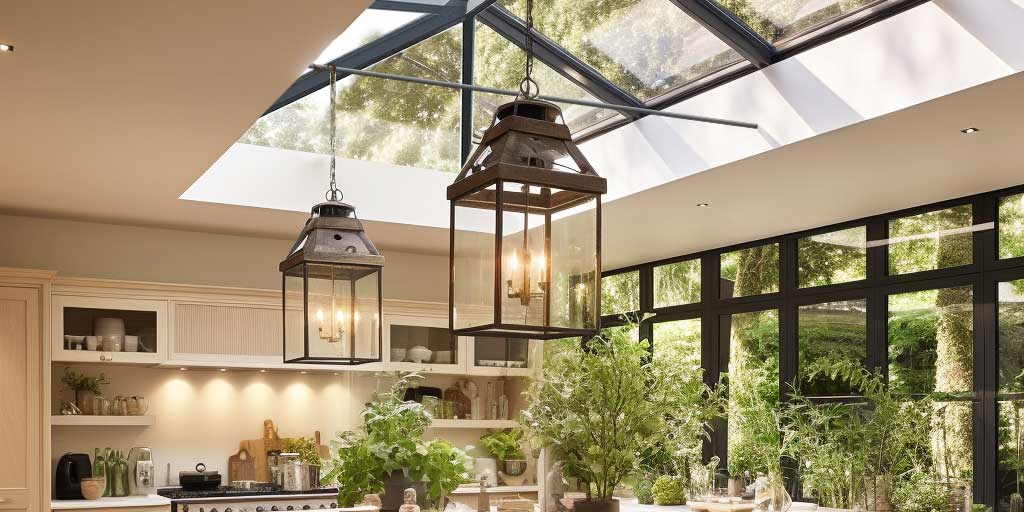
What way is my kitchen facing and what light will I get?
When planning your kitchen extension and considering the direction it faces, it’s important to understand how sunlight will impact the space. The direction your extension faces will determine the amount and type of natural light it receives throughout the day, influencing its comfort, energy efficiency, and overall ambiance. Here are the considerations for each direction:
North (N)
Direct Light:
- Minimal Direct Sunlight: A north-facing extension will receive minimal direct sunlight. It will be shaded for most of the day.
- Soft, Diffused Light: Light will be consistent and diffused, creating a cool and steady illumination.
Indirect Light:
- Even Lighting: North-facing windows provide a stable amount of indirect light throughout the day, ideal for rooms where consistent lighting is needed, like offices or studios.
- Reduced Heat Gain: This orientation helps in maintaining cooler temperatures, especially beneficial in warmer climates.
Northwest (NW)
Direct Light:
- Late Afternoon and Evening Sun: This direction receives direct sunlight in the late afternoon and evening, which can provide warmth and a golden glow to the space.
Indirect Light:
- Morning Shade: The extension will be in shade during the morning, receiving indirect light that keeps the space cool.
- Moderate Heat Gain: Late afternoon sun can increase heat, so consider heat-resistant glazing or shades.
East (E)
Direct Light:
- Morning Sun: An east-facing extension will receive abundant direct sunlight in the morning, creating a bright and warm start to the day.
Indirect Light:
- Afternoon Shade: By afternoon, the extension will be shaded, receiving cooler, indirect light, which can help in reducing heat gain later in the day.
Southeast (SE)
Direct Light:
- Morning to Midday Sun: This direction receives direct sunlight from early morning until midday, providing plenty of natural light and warmth during the first half of the day.
Indirect Light:
- Afternoon Shade: After midday, the light will become more indirect, which helps in maintaining comfortable temperatures during hotter parts of the day.
South (S)
Direct Light:
- All-Day Sun: A south-facing extension receives direct sunlight throughout the day, from morning to evening, ensuring maximum light exposure.
Indirect Light:
- Minimal Indirect Light: Direct sunlight dominates, but consider using shading solutions like awnings or blinds to control light and heat during peak hours.
Southwest (SW)
Direct Light:
- Afternoon to Evening Sun: Southwest-facing extensions get direct sunlight from early afternoon to evening, providing warmth and a bright, sunny atmosphere in the latter part of the day.
Indirect Light:
- Morning Shade: The extension will be in shade during the morning, receiving indirect light that keeps the space cooler.
West (W)
Direct Light:
- Afternoon and Evening Sun: West-facing extensions receive strong direct sunlight in the afternoon and evening, which can create a warm and bright end to the day.
Indirect Light:
- Morning Shade: Morning light will be indirect, helping to keep the space cool and comfortable before the intense afternoon sun.
Northeast (NE)
Direct Light:
- Early Morning Sun: This direction receives a small amount of direct sunlight early in the morning.
Indirect Light:
- Cool and Diffused Light: For most of the day, the light will be soft and indirect, providing a cool, even illumination.
When designing an extension, the direction it faces significantly impacts the type and amount of natural light it will receive. Here are some key considerations based on these directions:
- North-Facing: Ideal for consistent, indirect light with minimal heat gain, perfect for studios or offices.
- East-Facing: Benefits from bright morning light, good for kitchens or breakfast rooms.
- South-Facing: Maximizes direct sunlight throughout the day, ideal for living areas or sunrooms, but may require shading solutions.
- West-Facing: Enjoys warm afternoon and evening light, suitable for dining areas or patios.
- Northwest, Northeast, Southeast, and Southwest-Facing: These orientations offer a mix of direct and indirect light at different times of the day, providing versatile lighting conditions for various uses.
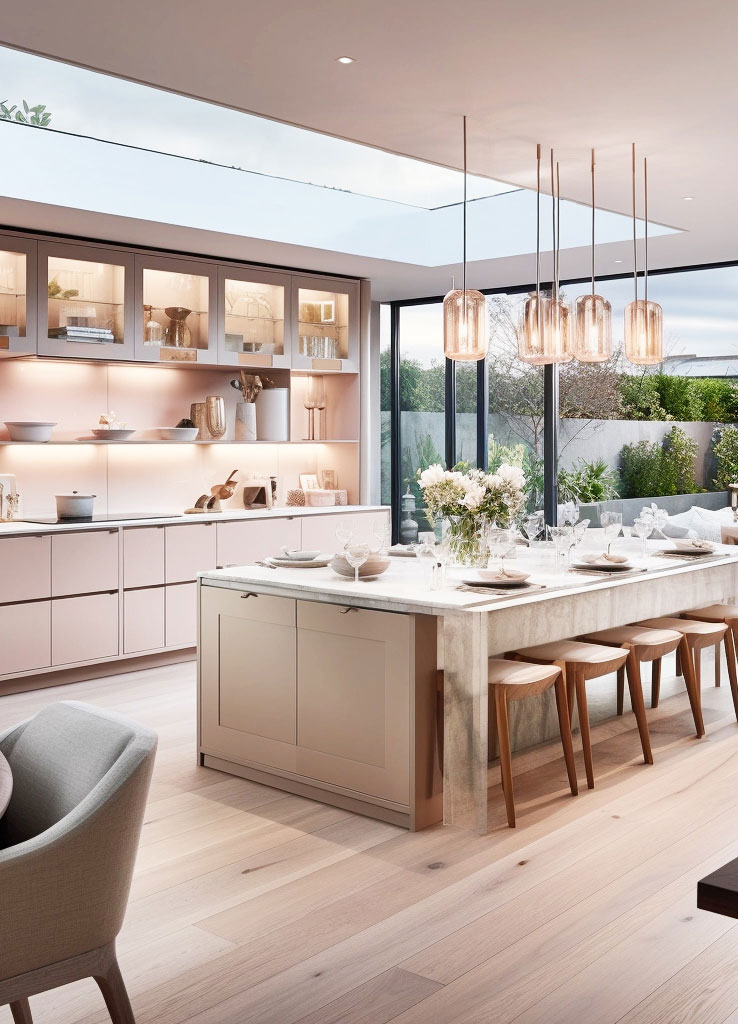
Where to Place Your Rooflights
When deciding where to place your rooflights, several important factors should be considered to ensure you maximize their benefits and avoid potential issues. Here’s a guide to help you make the best decision:
How Much Light?
Maximizing Light:
- Cover More Area: To maximize the amount of natural light, consider covering as much roof area as possible with glass. This is especially effective in dark or enclosed spaces.
- Considerations for Direct Sunlight: In areas with direct sunlight, large rooflights can cause glare and significant solar gain, increasing indoor temperatures. To mitigate these effects, use solar control glass, which reduces heat transmission, or install blinds to manage privacy and glare.
What Type of Light Do You Want?
Direct Light:
- Harshness of Direct Sunlight: Direct sunlight can be intense and create glare. To soften this, strategically place your rooflights. For example, slit rooflights (600-1200mm wide) positioned flush against a wall can help. The light bounces off the wall, providing a softer, diffused illumination.
- Architectural Details: Incorporating wood or plaster boarded beams can add architectural interest and diffuse light effectively. These beams can create interesting shadows and reduce the intensity of direct sunlight.
Indirect Light:
- Soft, Even Lighting: Indirect light is softer and more evenly distributed. This can be achieved by placing rooflights on the north side of your home or using diffusing elements like frosted glass or internal blinds.
Where Do You Want the Light?
Defining Spaces:
- Over Key Areas: Place rooflights strategically over specific areas to define and highlight them. For instance, a lantern rooflight over a dining table can create a focal point, while a flat glass rooflight over a kitchen galley can enhance the workspace.
- Impactful Placement: In larger, open-plan rooms, consider where additional light sources are located. If you have sliding, folding, or French doors at the front of the extension, placing rooflights near these doors might be less impactful. Instead, setting them back closer to the existing original wall can help light penetrate deeper into your home.
Functional Lighting:
- Work Areas: Positioning rooflights over work areas, such as kitchen countertops, can make these spaces brighter and more enjoyable to work in. Good lighting in these areas improves both functionality and comfort.
Additional Considerations
Solar Gain and Glare:
- Solar Control Glass: In sunny areas, using solar control glass can reduce heat build-up and glare, making the indoor environment more comfortable.
- Blinds: Installing blinds can help manage privacy and control the amount of light entering the room. This is especially useful if the rooflight is overlooked by neighboring properties.
Aesthetic and Practical Elements:
- Design Cohesion: Ensure the rooflights complement the overall design and architecture of your home. The right rooflight can add a striking visual element while improving natural light distribution.
- Energy Efficiency: Consider the thermal performance of the rooflights. Double or triple glazing can improve insulation, reducing energy costs and enhancing comfort.
By thoughtfully considering these aspects, you can optimize the placement of your rooflights to enhance the aesthetic, functionality, and comfort of your space. If you want more help or guidance feel free to talk to a member of our team.
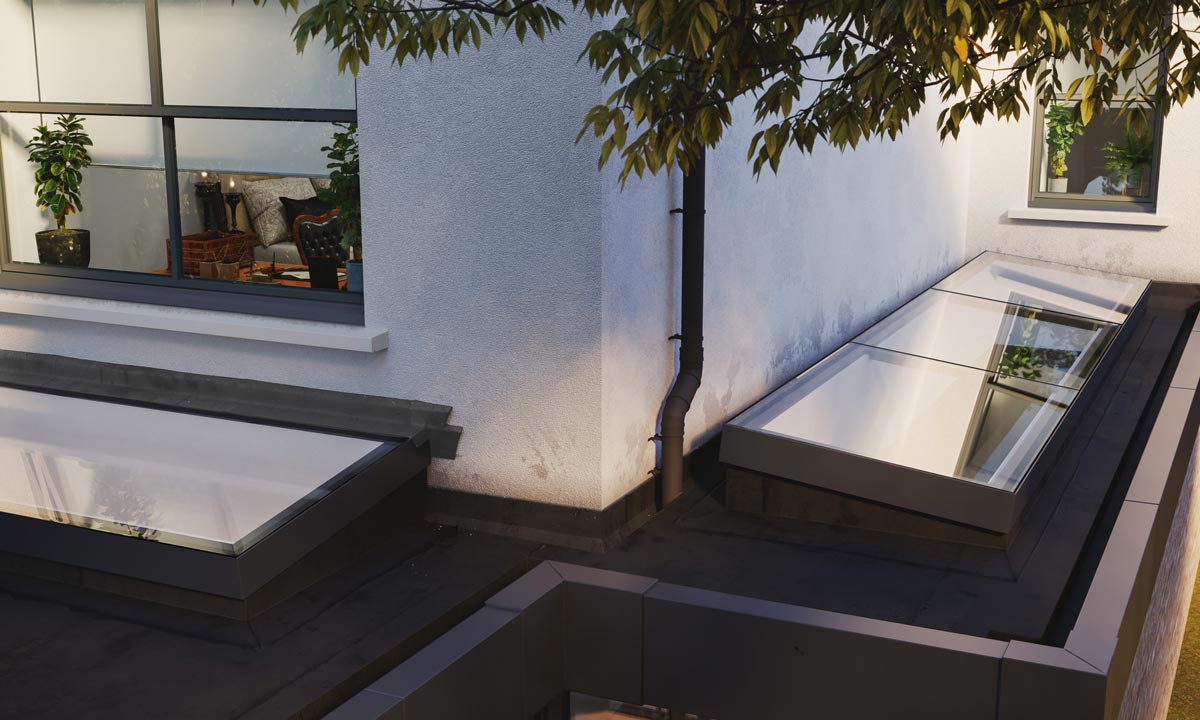
When and Where to Add Ventilation
Not sure if you need an opening rooflight? Ventilation can be a valuable addition to your rooflight, though it’s not always necessary. However, there are specific situations where it is highly beneficial:
High-Moisture Rooms
Kitchens, Laundry Rooms, and Bathrooms:
- Moisture Control: In rooms with high moisture levels, such as kitchens, laundry rooms, and bathrooms, an opening rooflight can help manage condensation. Modern rooflights are very efficient, but excess moisture can lead to condensation, which ventilation can easily remedy.
- Odor Removal: During cooking, an opening rooflight can quickly remove smells, steam, and smoke. This is particularly effective when used in conjunction with cross ventilation. An open window and a rooflight create a cross draft, providing a nice flow of fresh air.
Temperature Regulation
Top Floors and South-Facing Rooms:
- Heat Reduction: On the upper levels of a house, rising heat from central heating systems can make the top floor stuffy. Ventilation helps self-regulate the temperature in conjunction with thermostats, improving comfort.
- Solar Gain Management: In south-facing rooms with a lot of direct sunlight, large amounts of solar gain can increase indoor temperatures. Ventilation can help regulate this heat, keeping the space more comfortable.
Specific Considerations for Ventilation
Cross Ventilation:
- Efficient Airflow: For the best results, combine rooflights with other ventilation sources, like windows or vents. This creates cross ventilation, promoting efficient airflow throughout the space. A well-placed opening rooflight can significantly enhance this effect.
Ventilation in Living Spaces:
- Living Rooms and Bedrooms: While not always necessary, ventilation in living rooms and bedrooms can improve air quality and comfort. An opening rooflight can provide a refreshing breeze, especially during warmer months.
Climate Control:
- All-Year-Round Benefits: Ventilation is not just for the warmer months. In winter, it can help manage indoor humidity levels and prevent condensation, contributing to a healthier indoor environment.
Partner with Us for Your Skylight Kitchen Extension
Thinking of adding a skylight kitchen extension to your home? It’s a fantastic idea! Skylights increase natural light, reduce reliance on artificial lighting, and enhance well-being. Our team specializes in high-end, bespoke pitched and flat glass rooflights that are super thermally efficient. We offer custom-made fixed and opening skylights, ideal for ventilation and temperature regulation. With options for double or triple glazing and solar control glass, our skylights enhance comfort and energy efficiency. Contact us today to start planning your skylight kitchen extension and transform your space with our expert services.
Contact our team
If you have any questions, would like a bespoke price or want to enquire about our installation service. Give us a call or drop an email:
![]() 0208 462 3557
0208 462 3557

